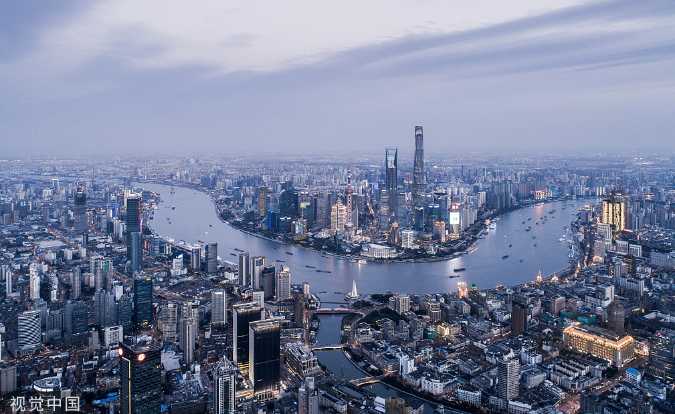
A view of Shanghai. [Photo/VCG]
Since the launch of the reform and opening-up policy in 1978, China has achieved remarkable growth, raising its share in the global GDP from 1.8 percent to 15.9 percent and lifting the world's largest population out of poverty. It is safe to say that China has been both a beneficiary of economic globalization and a major contributor to it.
From the mid-1980s to 2007, the world made huge progress in economic globalization. And during this period, China emerged to be a new driving force for global economic growth and prosperity.
In 2008, the US subprime crisis triggered a global financial tsunami that wreaked havoc on the global economy and caused job losses around the globe. In 2009, the world economy registered the first negative growth in over two decades at-0.1 percent and global trade slumped by 10.5 percent.
With its great macro-control capabilities, China took the lead in dragging the global economy out of the global financial crisis by tapping into domestic demand. From 2008 to 2012, China contributed 30.3 percent to global growth, effectively driving the rebound of global demand and injecting strong momentum into the recovery of the world economy.
In 2013, the Chinese economy entered a "new era" while continuing to make contributions to global growth and high-quality development. From 2013 to 2016, the annual global economic growth rate averaged 3.5 percent, still well short of the pre-crisis level. China nonetheless insisted on advancing its transition from rapid to high-quality growth, so as to solve the contradiction between unbalanced and inadequate development and meet the people's ever-growing needs for a better life.
At the same time it injected new momentum into the world's economic and trade development and made significant contributions to much needed infrastructure construction with the Belt and Road Initiative and the founding of the Asian Infrastructure Investment Bank.
From 2013 to 2017, China's contribution to global economic growth was more than that of the United States, Europe and Japan combined, and China's economic growth has played a pivotal role in promoting the rebalancing of the world economy, even as it has taken on the three tough battles of preventing and defusing financial risks, targeted poverty alleviation and pollution control.
However, affected by factors including rising trade protectionism and unilateralism, global economic growth has once again slowed since the second quarter of 2018, with the growth rate slipping from 3.8 percent in 2017 to 3.6 percent in 2018. It is expected to further slow to 3 percent in 2019.
However, economic globalization is an unstoppable trend of the times. Trade protectionism and unilateralism are an unjust cause that have scant support and they are doomed to fail. Economic globalization and free trade are the unshakable cornerstone of global growth and prosperity. As the world's largest developing nation, China will continue to unswervingly support economic globalization, safeguard the WTO-centric multilateral trading system with other countries and back up necessary reforms of the World Trade Organization.
To start with, China has an ultra-large domestic market that is still growing, which will constantly unleash momentum for high-quality growth. As of the end of 2018, China's urbanization rate had reached 59.6 percent, with urban population standing at around 830 million, which means that to meet the levels of the developed economies 30 percent of the total population, or 420 million, still needs to be urbanized. The ever-increasing and upgrading domestic demand provide a strong guarantee for China to resist external shocks and realize high-quality growth.
Second, China has a gradually maturing industrial system based on innovation, research and development, which is continuously increasing the core competitiveness of its economy.
Third, ongoing reform and opening-up will further stimulate vitality of the broader economy. By promoting market-oriented reforms and continuously expanding opening-up, China aims to foster a more convenient, market-oriented law-governed business environment. Improving the business environment is a crucial step toward increasing the efficiency of resource allocation, raising productivity and stabilizing economic growth.
Finally, China has a mature macroeconomic regulation and control system and enough leeway for macro policies to effectively resist downward risks and create a more stable environment for development.
Over the past few years, against the backdrop of mounting downward pressure, rather than adopting strong stimulus policies that would have an economy-wide impact or using the property sector as a short-term stimulus, China has intensified reform and opening-up to make space for policies aimed at coping with downward risks in the next phase.
It has also taken on the three tough battles of preventing and defusing financial risks, targeted poverty alleviation and pollution control. Having positive externalities for the world economy, these three tough battles are special contributions of China to the global community.
Having maintained a relatively low government debt ratio, China has space for more proactive fiscal policies aimed at stabilizing employment, improving people's well-being and strengthening infrastructure construction. In the meantime, internal and external factors, such as modest core CPI growth, PPI negative growth and the interest rate cuts recently adopted by many other countries, have created space for more pro-growth monetary policies by China
Using its macro policy, China is totally capable of coping with all risks and challenges and stabilizing economic growth by strengthening countercyclical adjustments.
The author is a research fellow at the National Academy of Development and Strategy at Renmin University of China.
The author contributed this article to China Watch exclusively. The views expressed do not necessarily reflect those of China Watch.
All rights reserved. Copying or sharing of any content for other than personal use is prohibited without prior written permission.

